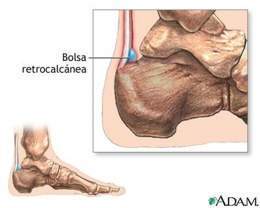Also known as retrocalcaneal bursitis, it is the swelling (inflammation) of the fluid-filled sac (bursa) at the back of the heel (calcaneus).

Causes, incidence, and risk factors
A bursa acts as a shock absorber and lubricant between the tendons and the muscles that slide over the bone . There are bursae around most of the large joints in the body, including the ankle.
The retrocalcaneal bursa is located at the back of the ankle at the heel and is where the large Achilles tendon connects the calf muscles to the heel. Repetitive or overuse of the ankle can cause this bursa to become irritated and inflamed. Possible causes are excessive walking, running, or jumping.
This condition is frequently associated with Achilles tendonitis . Retrocalcaneal bursitis can sometimes be confused with this type of tendonitis. Those at risk for this condition include people who have just started aggressive exercise regimens or who suddenly increase their activity without adequate conditioning.
Other causes
– Sometimes it is due to the change in the use of shoes between the high heels and the flat ones, which force to change the support points of the foot and others to the inflammation of the tissue that connects the sole of the foot, which is the plantar- facia muscle and the heel bone.
Another reason may be the way the legs and feet move in coordination, or the way they are structured in relation to each other.
They can also be caused as a result of a twist or blow.
Due to degenerative changes in the adipose tissue of the heel.
Due to having an inadequate plantar arch or some change in the plantar fascia, a structure that helps the foot to support the arch.
For small fractures in the calcaneus.
Due to a protrusion of the heel bone known as a spur or heel spur , which is usually formed by a fissure in the calcaneal bone and can be easily detected by means of an X-ray.
Conditions such as rheumatoid arthritis , lupus , gout , psoriasis , Morton’s neuroma or the presence of a foreign body in the heel, can be the cause of foot heel pain.
In general, the pain is more acute during the morning, when standing or walking and decreases as the heel “warms up” and people with flat feet or overweight are the most affected. The problem usually improves spontaneously as the inflammation of the soft tissues of the foot decreases, which can be achieved more quickly with the use of anti-inflammatories and sometimes the injection of hydrocortisone combined with a local anesthetic. The use of soft, gel or foam rubber insoles is also recommended to soften the footprint. To confirm the diagnosis, it is necessary to take an X-ray plateand to rule out arthritis a blood test is necessary and if the doctor considers it necessary an MRI can be performed to rule out bone tumors. Only in extreme cases is it recommended to use a night splint , removable cast , or surgery to free the ligaments or remove the spur if it exists.
Symptoms
Heel pain, especially when walking, running, or touching the area.
The pain may be worse when getting up on your toes (standing on your toes).
Hot red skin over the back of the heel.
Signs and tests
The doctor will take a medical history to see if symptoms of retrocalcaneal bursitis are present. Examining the ankle can find the location of the pain. The doctor will look for tenderness and redness on the back of the heel. The pain may be worse when the doctor bends the ankle up (dorsiflexion) or it may be worse when you stand on your toes. Imaging studies, such as X-rays and magnetic resonance imaging (MRI), are usually not necessary at first. If the first treatment fails to improve symptoms, your doctor may recommend these tests. MRI can show inflammation.
Treatment
Your doctor may recommend the following treatments:
Avoid activities that cause pain.
Ice your heels several times a day.
Take nonsteroidal anti-inflammatory drugs (for example, ibuprofen ).
Try custom or over-the-counter heel wedges to help reduce stress on the heel.
Using physical therapy to improve flexibility and strengthen the area around the ankle, which can help improve bursitis and prevent it from coming back.
If these treatments don’t work, the doctor may inject a small amount of steroids into the bursa. If this condition is associated with Achilles tendonitis, it may be effective to cast the ankle to prevent movement for a few weeks. In very rare cases, surgery may be necessary to remove the inflamed bursa.
Expectations (prognosis)
This condition usually improves within a few weeks with proper treatment.
Complications
Complications are not common. If bursitis is associated with tendonitis , tendon rupture is a possible complication. Tendon rupture can also occur with steroid injections, especially if they are given too often.
Situations that require medical assistance
If you have heel pain or retrocalcaneal bursitis symptoms that do not improve with rest, see your doctor for evaluation and treatment.
Prevention
To help prevent this condition, maintain proper posture when exercising, as well as good flexibility and strength around the ankle. Proper stretching of the Achilles tendon helps prevent injury.
Alternative names
Heel insertion pain
